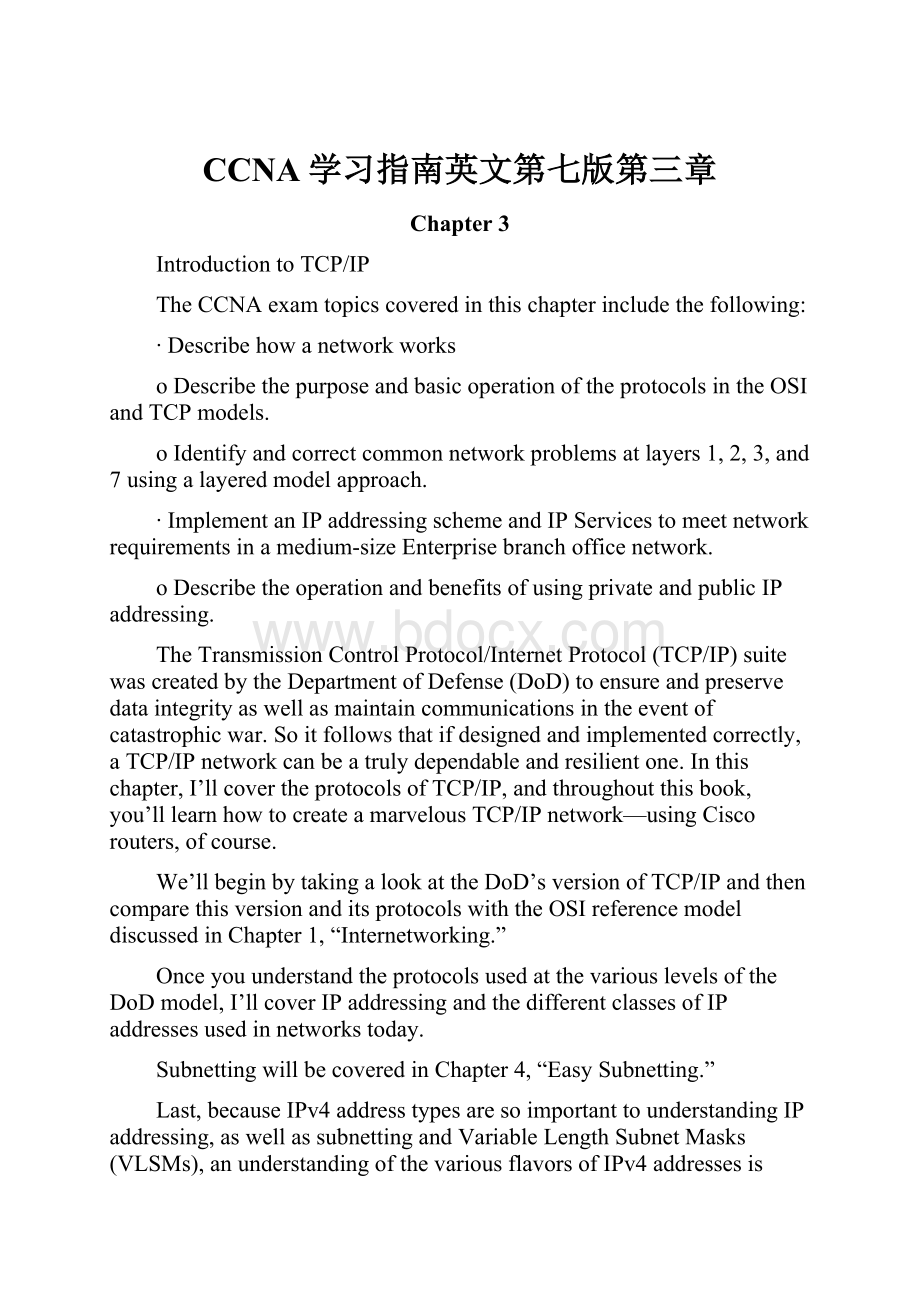CCNA学习指南英文第七版第三章.docx
《CCNA学习指南英文第七版第三章.docx》由会员分享,可在线阅读,更多相关《CCNA学习指南英文第七版第三章.docx(63页珍藏版)》请在冰豆网上搜索。

CCNA学习指南英文第七版第三章
Chapter3
IntroductiontoTCP/IP
TheCCNAexamtopicscoveredinthischapterincludethefollowing:
∙Describehowanetworkworks
oDescribethepurposeandbasicoperationoftheprotocolsintheOSIandTCPmodels.
oIdentifyandcorrectcommonnetworkproblemsatlayers1,2,3,and7usingalayeredmodelapproach.
∙ImplementanIPaddressingschemeandIPServicestomeetnetworkrequirementsinamedium-sizeEnterprisebranchofficenetwork.
oDescribetheoperationandbenefitsofusingprivateandpublicIPaddressing.
The TransmissionControlProtocol/InternetProtocol(TCP/IP) suitewascreatedbytheDepartmentofDefense(DoD)toensureandpreservedataintegrityaswellasmaintaincommunicationsintheeventofcatastrophicwar.Soitfollowsthatifdesignedandimplementedcorrectly,aTCP/IPnetworkcanbeatrulydependableandresilientone.Inthischapter,I’llcovertheprotocolsofTCP/IP,andthroughoutthisbook,you’lllearnhowtocreateamarvelousTCP/IPnetwork—usingCiscorouters,ofcourse.
We’llbeginbytakingalookattheDoD’sversionofTCP/IPandthencomparethisversionanditsprotocolswiththeOSIreferencemodeldiscussedinChapter1,“Internetworking.”
OnceyouunderstandtheprotocolsusedatthevariouslevelsoftheDoDmodel,I’llcoverIPaddressingandthedifferentclassesofIPaddressesusedinnetworkstoday.
SubnettingwillbecoveredinChapter4,“EasySubnetting.”
Last,becauseIPv4addresstypesaresoimportanttounderstandingIPaddressing,aswellassubnettingandVariableLengthSubnetMasks(VLSMs),anunderstandingofthevariousflavorsofIPv4addressesiscritical.I’llfinishthechapterwithvarioustypesofIPv4addressesthatyoujustmustknow.
InternetProtocolversion6willnotbediscussedinthischapter;thischapterwillfocussolelyonIPv4.IPv6willbecoveredinChapter15,“InternetProtocolVersion6(IPv6).”Also,whenIdiscussInternetProtocolVersion4,you’llseeitwrittenasjustIP,nottypicallyIPv4.
IntroducingTCP/IP
BecauseTCP/IPissocentraltoworkingwiththeInternetandintranets,it’sessentialforyoutounderstanditindetail.I’llbeginbygivingyousomebackgroundonTCP/IPandhowitcameaboutandthenmoveontodescribingtheimportanttechnicalgoalsdefinedbytheoriginaldesigners.Afterthat,you’llfindouthowTCP/IPcomparestoatheoreticalmodel—theOpenSystemsInterconnection(OSI)model.
ABriefHistoryofTCP/IP
TCP/IPfirstcameonthescenein1973.Later,in1978,itwasdividedintotwodistinctprotocols:
TCPandIP.Then,in1983,TCP/IPreplacedtheNetworkControlProtocol(NCP)andwasauthorizedastheofficialmeansofdatatransportforanythingconnectingtoARPAnet,theInternet’sancestorthatwascreatedbyARPA,theDoD’sAdvancedResearchProjectsAgency,waybackin1957inreactiontotheSoviet’slaunchingofSputnik.ARPAwassoonredubbedDARPA,anditwasdividedintoARPAnetandMILNET(alsoin1983);bothwerefinallydissolvedin1990.
Butcontrarytowhatyoumightthink,mostofthedevelopmentworkonTCP/IPhappenedatUCBerkeleyinNorthernCalifornia,whereagroupofscientistsweresimultaneouslyworkingontheBerkeleyversionofUNIX,whichsoonbecameknownastheBSD,orBerkeleySoftwareDistribution,seriesofUNIXversions.Ofcourse,becauseTCP/IPworkedsowell,itwaspackagedintosubsequentreleasesofBSDUNIXandofferedtootheruniversitiesandinstitutionsiftheyboughtthedistributiontape.Sobasically,BSDUnixbundledwithTCP/IPbeganassharewareintheworldofacademiaand,asaresult,becamethebasisofthehugesuccessandexponentialgrowthoftoday’sInternetaswellassmaller,privateandcorporateintranets.
Asusual,whatmayhavestartedasasmallgroupofTCP/IPaficionadosevolved,andasitdid,theU.S.governmentcreatedaprogramtotestanynewpublishedstandardsandmakesuretheypassedcertaincriteria.ThiswastoprotectTCP/IP’sintegrityandtoensurethatnodeveloperchangedanythingtoodramaticallyoraddedanyproprietaryfeatures.It’sthisveryquality—thisopen-systemsapproachtotheTCP/IPfamilyofprotocols—thatprettymuchsealeditspopularitybecauseitguaranteesasolidconnectionbetweenmyriadhardwareandsoftwareplatformswithnostringsattached.
TCP/IPandtheDoDModel
TheDoDmodelisbasicallyacondensedversionoftheOSImodel—it’scomposedoffour,insteadofseven,layers:
∙Process/Applicationlayer
∙Host-to-Hostlayer
∙Internetlayer
∙NetworkAccesslayer
Figure3-1 showsacomparisonoftheDoDmodelandtheOSIreferencemodel.Asyoucansee,thetwoaresimilarinconcept,buteachhasadifferentnumberoflayerswithdifferentnames.
WhenthedifferentprotocolsintheIPstackarediscussed,thelayersoftheOSIandDoDmodelsareinterchangeable.Inotherwords,theInternetlayerandtheNetworklayerdescribethesamething,asdotheHost-to-HostlayerandtheTransportlayer.
Figure3-1:
TheDoDandOSImodels
AvastarrayofprotocolscombineattheDoDmodel’s Process/Applicationlayer tointegratethevariousactivitiesanddutiesspanningthefocusoftheOSI’scorrespondingtopthreelayers(Application,Presentation,andSession).We’llbelookingcloselyatthoseprotocolsinthenextpartofthischapter.TheProcess/Applicationlayerdefinesprotocolsfornode-to-nodeapplicationcommunicationandalsocontrolsuser-interfacespecifications.
The Host-to-Hostlayer parallelsthefunctionsoftheOSI’sTransportlayer,definingprotocolsforsettinguptheleveloftransmissionserviceforapplications.Ittacklesissuessuchascreatingreliableend-to-endcommunicationandensuringtheerror-freedeliveryofdata.Ithandlespacketsequencingandmaintainsdataintegrity.
The Internetlayer correspondstotheOSI’sNetworklayer,designatingtheprotocolsrelatingtothelogicaltransmissionofpacketsovertheentirenetwork.IttakescareoftheaddressingofhostsbygivingthemanIP(InternetProtocol)address,andithandlestheroutingofpacketsamongmultiplenetworks.
AtthebottomoftheDoDmodel,the NetworkAccesslayer implementsthedataexchangebetweenthehostandthenetwork.TheequivalentoftheDataLinkandPhysicallayersoftheOSImodel,theNetworkAccesslayeroverseeshardwareaddressinganddefinesprotocolsforthephysicaltransmissionofdata.
TheDoDandOSImodelsarealikeindesignandconceptandhavesimilarfunctionsinsimilarlayers. Figure3-2 showstheTCP/IPprotocolsuiteandhowitsprotocolsrelatetotheDoDmodellayers.
Inthefollowingsections,wewilllookatthedifferentprotocolsinmoredetail,startingwiththeProcess/Applicationlayerprotocols.
TheProcess/ApplicationLayerProtocols
Inthefollowingsections,I’lldescribethedifferentapplicationsandservicestypicallyusedinIPnetworks.Thefollowingprotocolsandapplicationsarecovered:
∙Telnet
∙FTP
∙TFTP
∙NFS
∙SMTP
∙POP
∙IMAP4
∙TLS
∙SIP(VoIP)
∙RTP(VoIP)
∙LPD
∙XWindow
∙SNMP
∙SSH
∙HTTP
∙HTTPS
∙NTP
∙NNTP
∙SCP
∙LDAP
∙IGMP
∙LPR
∙DNS
∙DHCP/BootP
Figure3-2:
TheTCP/IPprotocolsuite
Telnet
Telnet isthechameleonofprotocols—itsspecialtyisterminalemulation.Itallowsauseronaremoteclientmachine,calledtheTelnetclient,toaccesstheresourcesofanothermachine,theTelnetserver.TelnetachievesthisbypullingafastoneontheTelnetserverandmakingtheclientmachineappearasthoughitwereaterminaldirectlyattachedtothelocalnetwork.Thisprojectionisactuallyasoftwareimage—avirtualterminalthatcaninteractwiththechosenremotehost.
Theseemulatedterminalsareofthetext-modetypeandcanexecutedefinedproceduressuchasdisplayingmenusthatgiveuserstheopportunitytochooseoptionsandaccesstheapplicationsonthedupedserver.UsersbeginaTelnetsessionbyrunningtheTelnetclientsoftwareandthenloggingintotheTelnetserver.
FileTransferProtocol(FTP)
FileTransferProtocol(FTP) istheprotocolthatactuallyletsustransferfiles,anditcanaccomplishthisbetweenanytwomachinesusingit.ButFTPisn’tjustaprotocol;it’salsoaprogram.Operatingasaprotocol,FTPisusedbyapplications.Asaprogram,it’semployedbyuserstoperformfiletasksbyhand.FTPalsoallowsforaccesstobothdirectoriesandfilesandcanaccomplishcertaintypesofdirectoryoperations,suchasrelocatingintodifferentones.
AccessingahostthroughFTPisonlythefirststep,though.Usersmustthenbesubjectedtoanauthenticationloginthat’sprobablysecuredwithpasswordsandusernamesimplementedbysystemadministratorstorestrictaccess.Youcangetaroundthissomewhatbyadoptingtheusername anonymous—thoughwhatyou’llgainaccesstowillbelimited.
Evenwhenemployedbyusersmanuallyasaprogram,FTP’sfunctionsarelimitedtolistingandmanipulatingdirectories,typingfilecontents,andcopyingfilesbetweenhosts.Itcan’texecuteremotefilesasprograms.
TrivialFileTransferProtocol(TFTP)
TrivialFileTransferProtocol(TFTP) isthestripped-down,stockversionofFTP,butit’stheprotocolofchoiceifyouknowexactlywhatyouwantandwheretofindit,plusit’ssoeasytouseandit’sfasttoo!
Itdoesn’tgiveyoutheabundanceoffunctionsthatFTPdoes,though.TFTPhasnodirectory-browsingabilities;itcandonothingbutsendandreceivefiles.Thiscompactlittleprotocolalsoskimpsinthedatadepartment,sendingmuchsmallerblocksofdatathanFTP,andthere’snoauthenticationaswithFTP,soit’sevenmoreinsecure.Fewsitessupportitbecauseoftheinherentsecurityrisks.
NetworkFileSystem(NFS)
NetworkFileSystem(NFS) isajewelofaprotocolspecializinginfilesharing.Itallowstwodi